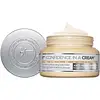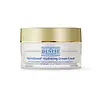What's inside
What's inside
 Key Ingredients
Key Ingredients

 Benefits
Benefits

 Concerns
Concerns

 Ingredients Side-by-side
Ingredients Side-by-side

Water
Skin ConditioningButylene Glycol
HumectantCyclopentasiloxane
EmollientGlycerin
HumectantButylene Glycol Dicaprylate/Dicaprate
EmollientEthylhexyl Isononanoate
EmollientHydrogenated Polyisobutene
EmollientCaprylic/Capric/Myristic/Stearic Triglyceride
EmollientGlyceryl Stearate
EmollientPEG-100 Stearate
Polyglyceryl-3 Methylglucose Distearate
EmulsifyingStearyl Behenate
EmollientDimethicone
EmollientPentaerythrityl Tetraethylhexanoate
EmollientBiosaccharide Gum-1
HumectantDimethicone/Vinyl Dimethicone Crosspolymer
Skin ConditioningCetearyl Alcohol
EmollientPalmitic Acid
EmollientStearic Acid
CleansingPolyethylene
AbrasivePEG/PPG-20/15 Dimethicone
EmulsifyingPhenyl Methicone
EmollientPortulaca Oleracea Extract
Skin ConditioningCocos Nucifera Oil
MaskingAloe Barbadensis Leaf Extract
EmollientButyrospermum Parkii Butter
Skin ConditioningHydroxyethyl Acrylate/Sodium Acryloyldimethyl Taurate Copolymer
Emulsion StabilisingSodium Hyaluronate
HumectantHydrogenated Lecithin
EmulsifyingPolyquaternium-51
Skin ConditioningNiacinamide
SmoothingHydrolyzed Collagen
EmollientCamellia Sinensis Leaf Extract
AntimicrobialTocopheryl Acetate
AntioxidantCarbomer
Emulsion StabilisingPEG-150 Distearate
EmulsifyingCeramide AP
Skin ConditioningGlycosphingolipids
EmollientGlyceryl Polymethacrylate
Meadowfoam Estolide
Skin ConditioningSorbitan Isostearate
EmulsifyingSqualane
EmollientPalmitoyl Pentapeptide-4
Skin ConditioningPolysorbate 20
EmulsifyingSteareth-20
CleansingN-Hydroxysuccinimide
Skin ConditioningChrysin
Skin ConditioningPalmitoyl Tripeptide-1
Skin ConditioningPalmitoyl Tetrapeptide-7
Skin ConditioningPolysorbate 60
EmulsifyingAleuritic Acid
Skin ConditioningYeast Extract
Skin ConditioningGlycoproteins
Skin ConditioningBetaine
HumectantHydrogenated Polydecene
EmollientCeramide NP
Skin ConditioningAllantoin
Skin ConditioningColloidal Oatmeal
AbsorbentRetinyl Retinoate
Skin ConditioningPolylactic Acid
AbrasiveCanola Oil
EmollientCholesteryl Nonanoate
EmollientAscorbyl Tetraisopalmitate
AntioxidantGlycyrrhiza Glabra Root Extract
BleachingChamomilla Recutita Flower Water
MaskingCurcuma Longa Root Extract
MaskingLeuconostoc/Radish Root Ferment Filtrate
AntimicrobialEruca Sativa Leaf Extract
Skin ConditioningGlyceryl Citrate/Lactate/Linoleate/Oleate
EmulsifyingCeteareth-20
CleansingHydroxypropyl Bispalmitamide Mea
EmollientGlycine Soja Sterols
EmollientMelaleuca Alternifolia Leaf Oil
AntioxidantPhytosteryl/Isostearyl/Cetyl/Stearyl/Behenyl Dimer Dilinoleate
Skin ConditioningSantalum Album Oil
MaskingChamomilla Recutita Flower Oil
MaskingCaprylhydroxamic Acid
Cetearyl Glucoside
EmulsifyingGlucose
HumectantStearyl Stearate
EmollientTromethamine
BufferingCitric Acid
Buffering1,2-Hexanediol
Skin ConditioningChlorhexidine Digluconate
AntimicrobialPotassium Sorbate
PreservativeDipropylene Glycol
HumectantLavandula Angustifolia Oil
MaskingCitrus Paradisi Peel Oil
MaskingCymbopogon Citratus Leaf Oil
MaskingPelargonium Graveolens Oil
MaskingCitrus Aurantium Dulcis Peel Oil
MaskingPogostemon Cablin Leaf Oil
MaskingCitrus Aurantium Bergamia Fruit Oil
MaskingEthylhexylglycerin
Skin ConditioningCaramel
Cosmetic ColorantDisodium EDTA
Phenoxyethanol
PreservativeCaprylyl Glycol
EmollientLimonene
PerfumingLinalool
PerfumingWater, Butylene Glycol, Cyclopentasiloxane, Glycerin, Butylene Glycol Dicaprylate/Dicaprate, Ethylhexyl Isononanoate, Hydrogenated Polyisobutene, Caprylic/Capric/Myristic/Stearic Triglyceride, Glyceryl Stearate, PEG-100 Stearate, Polyglyceryl-3 Methylglucose Distearate, Stearyl Behenate, Dimethicone, Pentaerythrityl Tetraethylhexanoate, Biosaccharide Gum-1, Dimethicone/Vinyl Dimethicone Crosspolymer, Cetearyl Alcohol, Palmitic Acid, Stearic Acid, Polyethylene, PEG/PPG-20/15 Dimethicone, Phenyl Methicone, Portulaca Oleracea Extract, Cocos Nucifera Oil, Aloe Barbadensis Leaf Extract, Butyrospermum Parkii Butter, Hydroxyethyl Acrylate/Sodium Acryloyldimethyl Taurate Copolymer, Sodium Hyaluronate, Hydrogenated Lecithin, Polyquaternium-51, Niacinamide, Hydrolyzed Collagen, Camellia Sinensis Leaf Extract, Tocopheryl Acetate, Carbomer, PEG-150 Distearate, Ceramide AP, Glycosphingolipids, Glyceryl Polymethacrylate, Meadowfoam Estolide, Sorbitan Isostearate, Squalane, Palmitoyl Pentapeptide-4, Polysorbate 20, Steareth-20, N-Hydroxysuccinimide, Chrysin, Palmitoyl Tripeptide-1, Palmitoyl Tetrapeptide-7, Polysorbate 60, Aleuritic Acid, Yeast Extract, Glycoproteins, Betaine, Hydrogenated Polydecene, Ceramide NP, Allantoin, Colloidal Oatmeal, Retinyl Retinoate, Polylactic Acid, Canola Oil, Cholesteryl Nonanoate, Ascorbyl Tetraisopalmitate, Glycyrrhiza Glabra Root Extract, Chamomilla Recutita Flower Water, Curcuma Longa Root Extract, Leuconostoc/Radish Root Ferment Filtrate, Eruca Sativa Leaf Extract, Glyceryl Citrate/Lactate/Linoleate/Oleate, Ceteareth-20, Hydroxypropyl Bispalmitamide Mea, Glycine Soja Sterols, Melaleuca Alternifolia Leaf Oil, Phytosteryl/Isostearyl/Cetyl/Stearyl/Behenyl Dimer Dilinoleate, Santalum Album Oil, Chamomilla Recutita Flower Oil, Caprylhydroxamic Acid, Cetearyl Glucoside, Glucose, Stearyl Stearate, Tromethamine, Citric Acid, 1,2-Hexanediol, Chlorhexidine Digluconate, Potassium Sorbate, Dipropylene Glycol, Lavandula Angustifolia Oil, Citrus Paradisi Peel Oil, Cymbopogon Citratus Leaf Oil, Pelargonium Graveolens Oil, Citrus Aurantium Dulcis Peel Oil, Pogostemon Cablin Leaf Oil, Citrus Aurantium Bergamia Fruit Oil, Ethylhexylglycerin, Caramel, Disodium EDTA, Phenoxyethanol, Caprylyl Glycol, Limonene, Linalool
Water
Skin ConditioningHydrogenated Polyisobutene
EmollientCyclopentasiloxane
EmollientCetearyl Alcohol
EmollientGlyceryl Stearate
EmollientGlycerin
HumectantDimethiconol
EmollientRetinol
Skin ConditioningCeramide Ns
Skin ConditioningPalmitoyl Oligopeptide
CleansingOryza Sativa Extract
AbsorbentHexapeptide-9
Skin ConditioningDipeptide-4
Skin ConditioningGlycolipids
Skin ConditioningGlycine Soja Oil
EmollientLecithin
EmollientEthylhexyl Cocoate
EmollientC12-15 Alkyl Benzoate
AntimicrobialTribehenin
EmollientDimethicone
EmollientCeteareth-20
CleansingLaureth-7
EmulsifyingParfum
MaskingPolyacrylamide
C13-14 Isoparaffin
EmollientCI 16035
Cosmetic ColorantCI 19140
Cosmetic ColorantTriethanolamine
BufferingDisodium EDTA
Phenoxyethanol
PreservativeEthylhexylglycerin
Skin ConditioningWater, Hydrogenated Polyisobutene, Cyclopentasiloxane, Cetearyl Alcohol, Glyceryl Stearate, Glycerin, Dimethiconol, Retinol, Ceramide Ns, Palmitoyl Oligopeptide, Oryza Sativa Extract, Hexapeptide-9, Dipeptide-4, Glycolipids, Glycine Soja Oil, Lecithin, Ethylhexyl Cocoate, C12-15 Alkyl Benzoate, Tribehenin, Dimethicone, Ceteareth-20, Laureth-7, Parfum, Polyacrylamide, C13-14 Isoparaffin, CI 16035, CI 19140, Triethanolamine, Disodium EDTA, Phenoxyethanol, Ethylhexylglycerin
 Reviews
Reviews

Ingredients Explained
These ingredients are found in both products.
Ingredients higher up in an ingredient list are typically present in a larger amount.
Ceteareth-20 is an emulsifier and cleansing agent. It is derived from cetearyl alcohol, a fatty alcohol.
As an emulsifier, Ceteareth-20 prevents oil and water from separating. It is also a surfactant. Surfactants help gather oil, pollution, and dirt to be washed away.
Cetearyl alcohol is a mixture of two fatty alcohols: cetyl alcohol and stearyl alcohol. It is mainly used as an emulsifier. Emulsifiers help prevent the separation of oils and products. Due to its composition, it can also be used to thicken a product or help create foam.
Cetearyl alcohol is an emollient. Emollients help soothe and hydrate the skin by trapping moisture.
Studies show Cetearyl alcohol is non-toxic and non-irritating. The FDA allows products labeled "alcohol-free" to have fatty alcohols.
This ingredient is usually derived from plant oils such as palm, vegetable, or coconut oils. There is debate on whether this ingredient will cause acne.
Due to the fatty acid base, this ingredient may not be Malassezia folliculitis safe.
Learn more about Cetearyl AlcoholCyclopentasiloxane, or D5, is a silicone used to improve texture of products and trap moisture.
D5 is considered lightweight and volatile. Volatile means it evaporates quickly after application. Once evaporated, D5 leaves a thin barrier that helps keep skin hydrated.
It is also an emollient. Emollients help soften the skin and prevent water loss. Silicones create a silky texture in products. D5 helps other ingredients become more spreadable.
Studies show D5 is safe to use in skincare products. We recommend speaking with a skincare professional if you have concerns.
Learn more about CyclopentasiloxaneDimethicone is a type of synthetic silicone created from natural materials such as quartz.
What it does:
Dimethicone comes in different viscosities:
Depending on the viscosity, dimethicone has different properties.
Ingredients lists don't always show which type is used, so we recommend reaching out to the brand if you have questions about the viscosity.
This ingredient is unlikely to cause irritation because it does not get absorbed into skin. However, people with silicone allergies should be careful about using this ingredient.
Note: Dimethicone may contribute to pilling. This is because it is not oil or water soluble, so pilling may occur when layered with products. When mixed with heavy oils in a formula, the outcome is also quite greasy.
Learn more about DimethiconeDisodium EDTA plays a role in making products more stable by aiding other preservatives.
It is a chelating agent, meaning it neutralizes metal ions that may be found in a product.
Disodium EDTA is a salt of edetic acid and is found to be safe in cosmetic ingredients.
Learn more about Disodium EDTAEthylhexylglycerin (we can't pronounce this either) is commonly used as a preservative and skin softener. It is derived from glyceryl.
You might see Ethylhexylglycerin often paired with other preservatives such as phenoxyethanol. Ethylhexylglycerin has been found to increase the effectiveness of these other preservatives.
Glycerin is already naturally found in your skin. It helps moisturize and protect your skin.
A study from 2016 found glycerin to be more effective as a humectant than AHAs and hyaluronic acid.
As a humectant, it helps the skin stay hydrated by pulling moisture to your skin. The low molecular weight of glycerin allows it to pull moisture into the deeper layers of your skin.
Hydrated skin improves your skin barrier; Your skin barrier helps protect against irritants and bacteria.
Glycerin has also been found to have antimicrobial and antiviral properties. Due to these properties, glycerin is often used in wound and burn treatments.
In cosmetics, glycerin is usually derived from plants such as soybean or palm. However, it can also be sourced from animals, such as tallow or animal fat.
This ingredient is organic, colorless, odorless, and non-toxic.
Glycerin is the name for this ingredient in American English. British English uses Glycerol/Glycerine.
Learn more about GlycerinGlyceryl Stearate is a mix of glycerin and stearic acid.
It is used to stabilize the mixing of water and oil ingredients. By preventing these ingredients from separating, it can help elongate shelf life. It can also help thicken the product's texture.
As an emollient, it helps soften skin and supports barrier-replenishing ingredients.
In cosmetics, Glyceryl Stearate is often made from vegetable oils or synthetically produced.
This ingredient may not be fungal-acne safe
Fun fact: The human body also creates Glyceryl Stearate naturally.
Learn more about Glyceryl StearateHydrogenated Polyisobutene is a synthetic polymer. Polymers are compounds with high molecular weight. Hydrogenated Polyisobutene is an emollient and texture enhancer.
In one study, Hydrogenated Polyisobutene showed better skin hydration levels than Caprylic/Capric Triglyceride. As an emollient, it helps keep your skin soft and hydrated by trapping moisture in.
Hydrogenated Polyisobutene is often used as a mineral oil replacement.
Learn more about Hydrogenated PolyisobutenePhenoxyethanol is a preservative that has germicide, antimicrobial, and aromatic properties. Studies show that phenoxyethanol can prevent microbial growth. By itself, it has a scent that is similar to that of a rose.
It's often used in formulations along with Caprylyl Glycol to preserve the shelf life of products.
Water. It's the most common cosmetic ingredient of all. You'll usually see it at the top of ingredient lists, meaning that it makes up the largest part of the product.
So why is it so popular? Water most often acts as a solvent - this means that it helps dissolve other ingredients into the formulation.
You'll also recognize water as that liquid we all need to stay alive. If you see this, drink a glass of water. Stay hydrated!
Learn more about Water